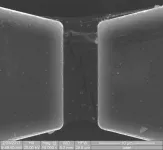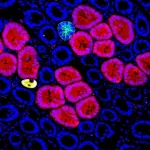INFORMATION:
USTC constructs a multiplexed quantum repeater based on absorptive quantum memories
2021-06-02
(Press-News.org) Chinese researchers realized an elementary link of a quantum repeater based on absorptive quantum memories (QMs) and demonstrated the multiplexed quantum repeater for the first time. On June 2nd?the work is published in Nature.
The fundamental task of a quantum network is to distribute quantum entanglement between two remote locations. However, the transmission loss of optical fiber has limited the distance of entanglement distribution to approximately 100 km on the ground. Quantum repeaters can overcome this difficulty by dividing long-distance transmission into several short-distance elementary links. The entanglement of two end nodes of each link is created firstly. Then the entanglement distance is gradually expanded through entanglement swapping between each link.
Previously, an elementary link of a quantum repeater has been realized in cold atomic ensembles and single quantum systems. These demonstrations are all based on emissive QMs, in which the entangled photons are emitted from QMs. Quantum repeaters constructed by emissive QMs have simple structures, but poor compatibilities. It is of great challenge to support deterministic entanglement sources and multiplexed operations simultaneously, which are two key technologies to enhance the entanglement distribution rate. Quantum repeaters based on absorptive QMs can overcome such limitation because they separate the quantum memories and the entangled photon sources.
The research team, led by Prof. LI Chuanfeng and Prof. ZHOU Zongquan from University of Science and Technology of China (USTC), focuses on the research of absorptive QMs based on rare-earth-ion-doped crystals. For this kind of QMs, the entanglement source can be flexibly selected, including deterministic entanglement sources, while remaining the capability of multiplexed operations, and therefore should be more efficient for quantum repeater applications. In this work, they used external entangled photon-pair sources (EPPSs) based on spontaneous parametric down-conversion and achieved heralded entanglement distribution between two absorptive QMs for the first time.
They built an elementary link with an intermediate station and two nodes at the ends. Each node contains an absorptive QM with a bandwidth of 1GHz and a bandwidth-matched EPPS. In each node, one entangled photon of each photon pair was stored in the "Sandwich-like" QM while the other was transmitted to the middle station for joint Bell-state measurement (BSM). A successful entanglement swapping operation was heralded by the successful click of BSM. The entanglement between two QMs 3.5 meters apart was established with a fidelity of approximately 80.4%, although there weren't any direct interactions between two remote QMs. Four temporal modes were employed in this demonstration of an elementary link of a quantum repeater, accelerating the entanglement distribution rate by four times.
Prof. ZHOU Zongquan said: "The use of absorptive quantum memory is expected to achieve high efficiency quantum repeater and quantum network in the future, and further promote the communication between 'Cowherd and Weaver Girl' in the quantum world."
This work provides a feasible roadmap for the development of practical quantum repeaters and lays the foundation for the construction of high-speed quantum networks. Reviewers pointed out"The present work focuses on the ensemble approach, which has a number of advantages in the context of quantum repeater applications, multiplexing for instance". They highly recommend this work as"a significant accomplishment that will form the basis for further research" and "a major step forward in the development of a practical quantum repeater".
Prof. LI Chuanfeng said that the team will continue to improve the indicators of absorptive QM, " we will use deterministic entanglement source to greatly improve the entanglement distribution rate, and to achieve practical quantum repeaters beyond direct transmission of optical fiber."
LIU Xiao and HU Jun from CAS Key Laboratory of Quantum Information and CAS Center for Excellence in Quantum Information and Quantum Physics are the co-first authors. The corresponding authors are Prof. LI Chuanfeng and Prof. ZHOU Zongquan.
For future developments, the research team will continue to improve the performances of the absorptive QMs, and adopt deterministic entanglement sources, so as to greatly enhance the entanglement distribution rate, and to achieve a practical quantum repeater that outperform the direct transmission of photons.
ELSE PRESS RELEASES FROM THIS DATE:
Hexagonal boron nitride's remarkable toughness unmasked
2021-06-02
HOUSTON - (June 2, 2021) - It's official: Hexagonal boron nitride (h-BN) is the iron man of 2D materials, so resistant to cracking that it defies a century-old theoretical description engineers still use to measure toughness.
"What we observed in this material is remarkable," said Rice University's Jun Lou, co-corresponding author of a Nature paper published this week. "Nobody expected to see this in 2D materials. That's why it's so exciting."
Lou explains the significance of the discovery by comparing the fracture toughness of h-BN with that of its better-known cousin ...
Clinical trial launched following discovery that psychiatric drug may prevent bowel cancer
2021-06-02
The study, published in the journal Nature, shows how a drug available on the NHS can boost fitness of healthy stem cells in the gut, making them more resistant to sabotage from mutant stem cells that cause cancer.
Researchers in the Netherlands, funded by the UK charity Worldwide Cancer Research, have discovered a way to boost the fitness of healthy cells in the gut to prevent the development of bowel cancer. The findings have led to the initiation of a clinical trial to find out if a commonly used psychiatric drug could be used to prevent bowel cancer in people. The trial will recruit patients with a genetic mutation that means they are virtually 100% certain to develop bowel cancer in their lifetime, unless ...
Researchers identify how to prevent cancer metastases
2021-06-02
Metastases can develop in the body even years after apparently successful cancer treatment. They originate from cancer cells that migrated from the original tumor to other organs, and which can lie there inactive for a considerable time. Researchers have now discovered how these "sleeping cells" are kept dormant and how they wake up and form fatal metastases. They have reported their findings in the journal Nature.
A tumor can leave behind an ominous legacy in the body: cancer cells can migrate from the tumor to other tissues in the body, where they survive after treatment in a kind of hibernation called dormancy. Currently, cancer medicine relies on monitoring cancer patients ...
Coloring tumors reveals their bad influence
2021-06-02
Studies on cancer are limited by the threshold at which cellular transformations become clinically detectable. However, the very initial phase on the way to malignancy is histologically invisible, as the process originates from one single cell. In this early phase, a so-called "seeding cell" acquires an initial pro-cancerous mutation, also known as the "first oncogenic hit", while being completely surrounded by normal tissue. To overcome the detection barrier, a team of researchers around IMBA group leader Bon-Kyoung Koo and University of Cambridge group leader Professor Benjamin D. Simons developed a laboratory system to dissect the pre-cancerous steps that remained under the radar ...
Urban crime fell by over a third around the world during COVID-19 shutdowns, study suggests
2021-06-02
A team of researchers led by the University of Cambridge and University of Utrecht examined trends in daily crime counts before and after COVID-19 restrictions were implemented in major metropolitan areas such as Barcelona, Chicago, Sao Paulo, Tel Aviv, Brisbane and London.
While both stringency of lockdowns and the resulting crime reductions varied considerably from city to city, the researchers found that most types of crime - with the key exception of homicide - fell significantly in the study sites.
Across all 27 cities, daily assaults fell ...
Income level, literacy, and access to health care rarely reported in clinical trials
2021-06-02
Clinical trials published in high-profile medical journals rarely report on income or other key sociodemographic characteristics of study participants, according to a new study that suggests these gaps may create blind spots when it comes to health care, especially for disadvantaged populations.
The study, publishing June 2 in JAMA Network Open, analyzed 10 per cent of 2,351 randomized clinical trials published in New England Journal of Medicine, JAMA, The BMJ, The Lancet and Annals of Internal Medicine between Jan. 1, 2014 and July 31, 2020.
The most commonly reported sociodemographic variables were sex and gender (in 98.7 per cent of trials) and race/ethnicity (in 48.5 per cent). All other sociodemographic ...
Salps fertilize the Southern Ocean more effectively than krill
2021-06-02
Experts at the Alfred Wegener Institute have, for the first time, experimentally measured the release of iron from the fecal pellets of krill and salps under natural conditions and tested its bioavailability using a natural community of microalgae in the Southern Ocean. In comparison to the fecal pellets of krill, Antarctic phytoplankton can more easily take up the micronutrient iron from those produced by salps. Observations made over the past 20 years show that, as a result of climate change, Antarctic krill are increasingly being supplanted by salps in the Southern Ocean. In the future, salps could more effectively stimulate the fixation of the greenhouse gas carbon dioxide in Antarctic microalgae than krill, as the team of researchers report ...
Protein disguise could be new target for cancer immunotherapy
2021-06-02
Peer reviewed
Experimental study / Meta-analysis
Animals / Human data
Protein disguise could be new target for cancer immunotherapy
Researchers at the Francis Crick Institute have identified a protein that helps tumours evade the immune system and, in certain types of cancers, is linked to a poorer chance of survival. The protein could become a target for future cancer treatments.
A crucial part of the immune system's response to cancer is a group of white blood cells, called CD8+ T-cells, which kill tumour cells. Before they launch their anti-tumour response, these cells must be told who to attack by another immune cell, ...
Less aviation during the global lockdown had a positive impact on the climate
2021-06-02
They studied the extent to which cirrus clouds caused by aircraft occurred during the global hard lockdown between March and May 2020, and compared the values with those during the same period in previous years. The study was led by Johannes Quaas, Professor of Theoretical Meteorology at Leipzig University, and has now been published in the renowned journal "Environmental Research Letters".
Cirrus clouds, known for their high, wispy strands, contribute to warming the climate. When cirrus clouds occur naturally, large ice crystals form at an altitude of about 36 kilometres, in turn reflecting sunlight back into space - albeit ...
The feasibility of transformation pathways for achieving the Paris Climate Agreement
2021-06-02
What drives the feasibility of climate scenarios commonly reviewed by organizations like the Intergovernmental Panel on Climate Change (IPCC)? And can they actually be achieved in practice? A new systematic framework can help understand what to improve in the next generation of scenarios and explore how to make ambitious emission reductions possible by strengthening enabling conditions.
While the IPCC is in the midst of the drafting cycle of the Sixth Assessment Report, whose publication will start in the second half of 2021, there is an ongoing debate ...



